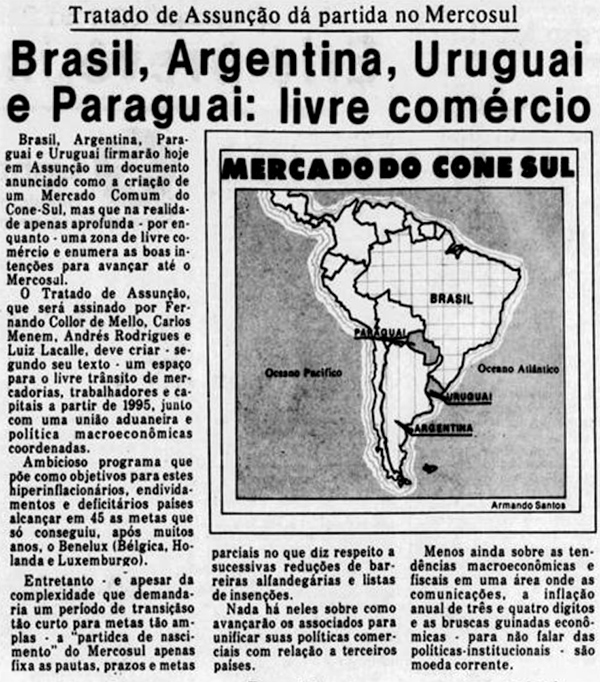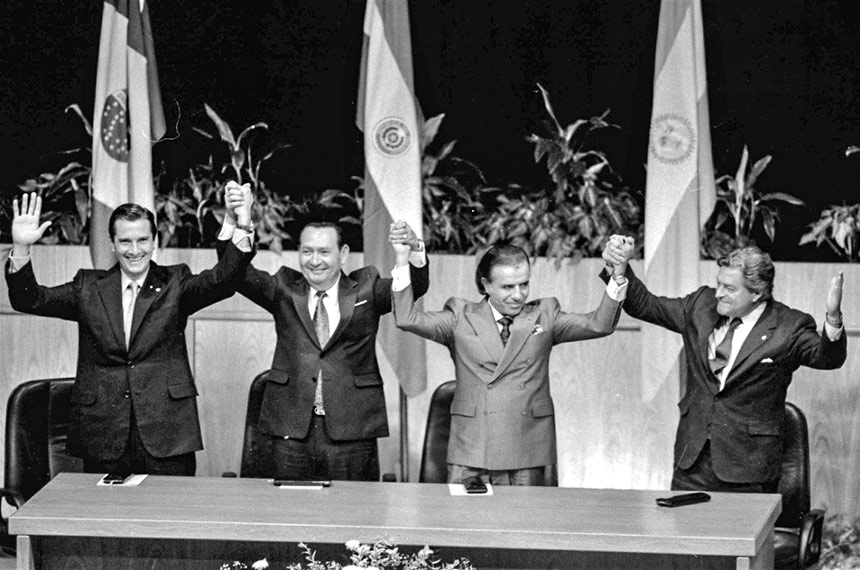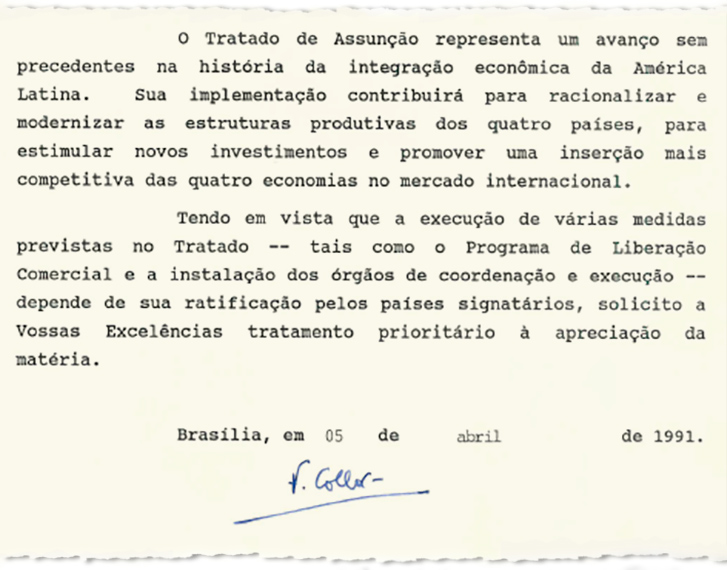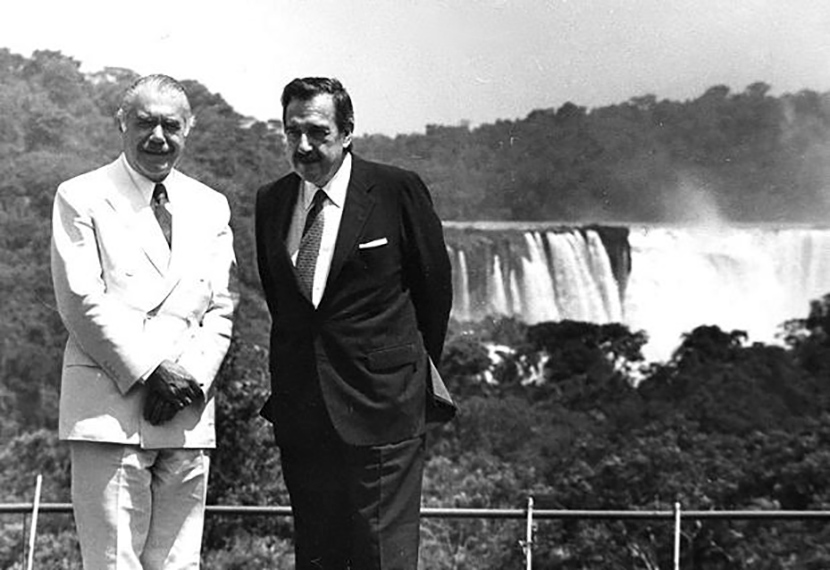RIO DE JANEIRO, BRAZIL – This month marks 30 years since the presidents of Brazil, Argentina, Uruguay, and Paraguay, meeting in Asunción, signed the document creating Mercosur.
From this act, a regional bloc was born, which today, if it were a single country, would emerge as the 9th largest economy on the planet. Brazil alone is the 12th largest economy in the world, according to International Monetary Fund (IMF) statistics.
Documents kept in the Senate Archive show that the senators, from Brasilia, followed with attention the historic international ceremony of March 26, 1991, in which Fernando Collor, Carlos Menem, Luis Lacalle and Andrés Rodríguez signed the Treaty of Asunción.
– At the ceremony, President Collor said: ‘We have begun to write our own modernity. In fact, the treaty is of great significance,” said Senator Marco Maciel the next day.

– The integration process may be the key to a more competitive insertion of our countries in the world. Mercosur will provide economies of scale and optimize comparative advantages, leading to a reduction in production costs. The project will also stimulate trade flows between the four countries and make investments more attractive in the region, with positive consequences for the fight against inflation and the quality of life of the population – continued the congressman.
Under the Asunción Treaty, the four countries gradually eliminated or reduced customs duties in transactions among themselves and also unified import and export taxes on trade with other nations.
Beyond the economic benefits, the creation of Mercosur allowed the distrust and diplomatic tensions between the River Plate (Rio de la Plata) countries, especiallly Brazil and Argentina, to finally come to an end.
This situation started in the colonial era (when Portugal and Spain disputed the South American territory), persisted during the Empire (1808 – 1889) (when the Cisplatina and Paraguayan Wars were fought and there was Brazilian interference in Uruguayan politics), and was renewed at the beginning of the Republic, when neighbors from the Southern Cone did not look favorably on Baron Rio Branco’s claim to diplomatic leadership in South America.
“Even the alliance between Brazil and Argentina to confront Solano López [in the Paraguayan War] was, as we now know, an emergency alliance between partners who looked at each other with mistrust, but who at that time feared a [common] enemy that was expanding and advancing,” Senator Alberto Lavinas said in 1980.
In the early 1940s, during the dictatorship of the Estado Novo, President Getúlio Vargas tried a rapprochement with the Argentines. The plans were promising, but they fell apart when Brazil and Argentina decided to take different positions in the Second World War. While the Brazilians entered the conflict on the side of the allies, the Argentineans chose neutrality.
In 1985, in a public hearing in the Senate, the president of Petrobras, Carlos Theóphilo de Souza e Mello, said a short sentence that revealed the size of the economic rivalry that separated Brazil and Argentina:
“Argentina has serious difficulties reaching international markets because of its very shallow waters. This is very good for Brazil. The waters of the Rio da Prata require a very large amount of dredging for a draught of eight to ten meters. Today they are studying a port further out from the bar of the Rio de la Plata, to see if they can get better draughts, of 12 meters, so that their products can reach the foreign market with competitive advantages over Brazil.”
In the same year, Senator José Ignacio Ferreira dealt with a supposed arms race in the Southern Cone: “It makes no sense for Brazil and Argentina to launch themselves into a technological competition that could lead to nuclear weapons. Instead, the countries should get together to solve the issue of foreign debt, illiteracy, basic sanitation, slums.”
In 1991, Senator Pedro Simon cited an almost prosaic case of the historic disagreement between Brazilians and Argentines: “The two countries got along so badly in the past that we made in Rio Grande do Sul a railroad with a narrow gauge, different from Argentina’s wide gauge, just to make a possible invasion of Brazil by the Argentines more difficult.”

For Simon, “the North” created “gossip” that had no reason to exist between Brazil and Argentina. Senator Dirceu Carneiro, in a statement in 1993, reinforced this thesis:
“The Treaty of Asunción had the extraordinary virtue of burying a many-year history of relations of mutual distrust. The military sector always fed the hypothesis of a conflict between Brazil and Argentina and, to this end, suffered the interference of the First World, with evidently its own pragmatic interests, investing in a progressive disunity between the countries, causing us to turn our backs on our neighbors. During this entire period, Brazil did not consider the culture nor the richness of the commercial exchanges with its neighboring countries. Throughout this period, our eyes were turned toward Europe, toward the United States, toward the Atlantic.”
The first steps toward rapprochement between Brazil and Argentina were taken in 1979, when the countries settled their dispute over hydroelectric projects in the Paraná River Basin. From then on, there have only been advances. In 1980, they signed an agreement on the peaceful use of nuclear technology. In 1982, Brazil expressed support for Argentina’s claims in the Falkland (Malvinas) War.
In 1985, presidents José Sarney and Raúl Alfonsín took advantage of the inauguration ceremony of the Tancredo Neves Bridge between Foz do Iguaçu and Puerto Iguazú to sign the Iguazú Declaration, which foresaw integration between the two countries. Brazil and Argentina had just emerged from military dictatorships, and the re-democratization facilitated the rapprochement.
“We can see that there is an advance like never before,” said Simon. “If we compare all the presidents of the Republic, since the first one, Deodoro, we will see that all of them together did not visit Argentina as often as President Sarney did.”
“There was a question mark regarding president Collor – whether he would dedicate himself body and soul to the integration cause. After all, he campaigned so hard and so acidly against President Sarney. Justice be done. He took office on March 15 [1990]; on the 16th, President Collor and President Menem signed agreements in the Planalto Palace. Both men made a point of showing that they would defend, that they would fight, that they would advance the cause of Brazil-Argentina integration.”
The Iguazú Declaration is considered the embryo of the Asunción Treaty. Uruguay and Paraguay, which had watched their neighbors sign agreement after agreement from 1985 on, realized that the alliance was promising and decided to join the group. This is how the accelerated thawing of bilateral relations between Brazil and Argentina gave rise to Mercosur.
“The two presidents [Sarney and Alfonsín], since the inauguration of the Tancredo Neves Bridge, have been determined to steer the economies of both countries towards an integration with which they can reach a marked future.
The integration starts with both of them. Then will come Uruguay. Then it will be Chile’s turn. It was integration, through the European Common Market, that saved Europe from poverty and dependence. So, it seems to me that the solution for the poverty of our country and our region is its integration into a common market ,” said, in 1989, senator Ney Maranhão.

Another reason that led to the creation of the European Economic Community (the predecessor of today’s European Union) in 1958 was precisely a historical rivalry. Germany and France had been involved, always on opposite sides, in the bloodiest battles in the history of Europe, including the two World Wars. When both economies were umbilically connected, the attempt to destroy each other turned into a bad deal. Germans and French never faced each other again.
The historical papers in the Senate Archives indicate, however, that Mercosur was not unanimous. Some parliamentarians viewed the new bloc with skepticism, reservations and even fears. In 1992, Senator Gerson Camata said that farmers from the state of Rio Grande do Sul were buying land in Uruguay and stopping planting in Brazil and that companies such as Autolatina, Cofap and Brahma were producing in Argentina to export to the Brazilian market:
“The terms of the Asuncion Treaty are unfavorable to Brazil’s interests. What are we gaining in the first year? We start losing billions of dollars in these exchanges with Argentina, Uruguay and Paraguay. We are giving up the power to make decisions, giving up our market, in favor of these countries, which are smaller. We are losing jobs, income and taxes.”
In his pronouncement, Camata warned that Brazil still had time to abandon Mercosul: “Fortunately for Brazil, the treaty provides that any of its members can withdraw from it as long as it denounces it. The sooner Brazil denounces this treaty, the better it will be.”
Still in 1992, Senator Fernando Henrique Cardoso said that, although he was in favor of Brazil’s integration with its neighbors, Mercosul had side effects that could not be ignored:
“Recently, I went to the interior of São Paulo, to São José do Rio Pardo, where I found a despondent situation. Onions, the basis of wealth in the region, had been completely displaced by imports from Argentina. Now, in a short time we will be totally bound by the Asunción Treaty. If we don’t take the relevant measures in due time, integration, which is a positive fact, will have a very high cost, capable of destroying certain wealth bases locally.”
One year after the ceremony in Asunción, Senator Nelson Wedekin criticized the fact that the treaty is exclusively commercial:
“By privileging the market aspects, the Asuncion Treaty underestimated a perspective that could be much more comprehensive. The concept we defend is the integration of the peoples of the four countries. Our efforts should add up to the search for economic growth and social progress, and not only to highlight the economy from the business community’s point of view. For now, Mercosur is within these narrow limits. Nobody has yet even considered an alliance of member countries to jointly negotiate the external debt. Mercosur could be a privileged space that would produce the reactivation of our economies and a policy of income and wealth distribution. This, however, cannot be expected from the elites of the four member countries, who, at best, are capable of seeing Mercosur as a mere pact to expand their businesses.”
Despite criticism from some senators, the National Congress ratified the Treaty of Asunción in September 1991, six months after the presidents met in Paraguay.
Over time, Mercosur ceased to be exclusively economic and began to address cultural and social aspects as well. High schools in Brazil, for example, were obliged to offer Spanish classes. University students from one country can continue their studies in another country of the block. The government created in Foz do Iguaçu, on the border with Argentina and Paraguay, the Federal University of Latin American Integration (Unila), which trains students from the Mercosur countries in courses aimed at regional development.
The time of work and social security contributions in any country of the bloc is now counted for retirement purposes. Migratory procedures for tourists in the bloc were made easier, dispensing with the need to present a passport. The procedures for temporary and permanent residence have also become less bureaucratic. The vehicle license plates were standardized, to allow a more agile displacement between countries.
According to legislative consultant Maria Claudia Drummond, who has accompanied Mercosul in the Senate since the signing of the Treaty of Asunción, the bloc has helped Brazil to open up to the world:
“Until then, Brazil was a very closed country, both in exports and imports. The opening occurred first to the Mercosur countries, and not to the world all at once. Because of Mercosul, it was a process that was done in a controlled way, little by little.”

She observes that Brazilians in general have little knowledge about the block:
“In Argentina, Uruguay and Paraguay, Mercosur is much better known. Because the territories are smaller and people cross the border more, Mercosur is more real to them. Even the academic interest in Mercosur is stronger in these countries. Here in Brazil, the lack of interest is almost total and this has been accelerating in recent years.”
For economist Luciano Wexell Severo, professor at Unila and coordinator of the South American Economic Integration Observatory, Brazilian citizens’ lack of interest contributes to the weakening of the bloc:
“As Brazil has a very large territory, there is an appearance of self-sufficiency. But it’s not so. Today 85% of the items that Brazil exports to the Mercosul countries are industrialized, such as cars, bodies, engines, beer and footwear. These are items that generate more jobs, income, tax revenue, and technology than primary products, such as soy, cellulose, and meat, which we export to China. Many times the workers in these industries do not know that the integration with Argentina, Uruguay, and Paraguay is important for them. Therefore, these workers do not exert political pressure in favor of Mercosur. This is bad because Brazil is unlikely to have a thriving economy, with all the social benefits that come with it, without this rapprochement with our neighbors.”
Venezuela became the fifth member nation of Mercosur in 2012, but was suspended in 2016 for failing to comply with agreements and treaties. Bolivia has been in the admission process since 2015.
Source: Senate Agency (Agência Senado)

